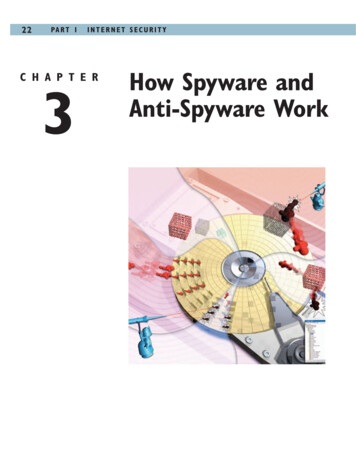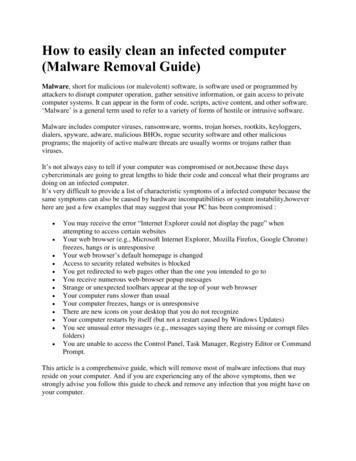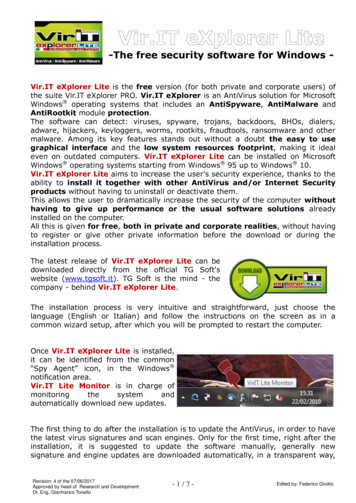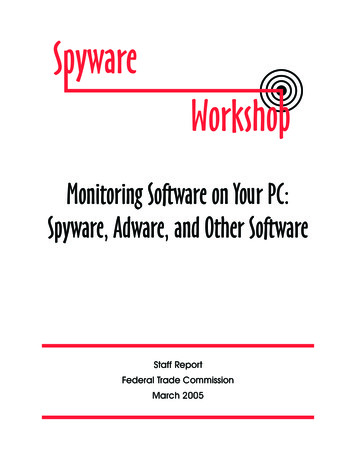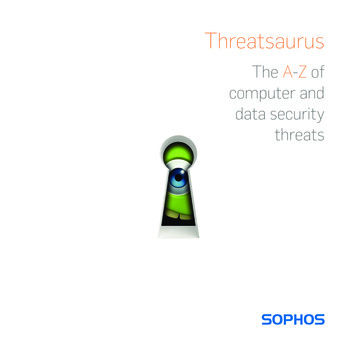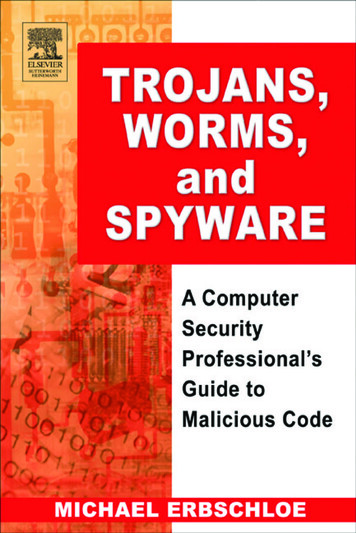
Transcription
TROJANS, WORMS, AND SPYWARE
This page intentionally left blank
TROJANS, WORMS, AND SPYWAREA Computer Security Professional’s Guideto Malicious CodeMichael ErbschloeAMSTERDAM BOSTON HEIDELBERG LONDONNEW YORK OXFORD PARIS SAN DIEGOSAN FRANCISCO SINGAPORE SYDNEY TOKYO
Elsevier Butterworth–Heinemann200 Wheeler Road, Burlington, MA 01803, USALinacre House, Jordan Hill, Oxford OX2 8DP, UKCopyright 2005, Elsevier Inc. All rights reserved.No part of this publication may be reproduced, stored in a retrieval system, ortransmitted in any form or by any means, electronic, mechanical, photocopying,recording, or otherwise, without the prior written permission of the publisher.Permissions may be sought directly from Elsevier’s Science & Technology RightsDepartment in Oxford, UK: phone: ( 44) 1865 843830, fax: ( 44) 1865 853333,e-mail: permissions@elsevier.com.uk. You may also complete your request on-linevia the Elsevier homepage (http://elsevier.com), by selecting “Customer Support”and then “Obtaining Permissions.”Recognizing the importance of preserving what has been written, Elsevier prints itsbooks on acid-free paper whenever possible.Library of Congress Cataloging-in-Publication DataApplication submitted.British Library Cataloguing-in-Publication DataA catalogue record for this book is available from the British Library.ISBN: 0-7506-7848-8For information on all Butterworth–Heinemann publicationsvisit our website at http://books.elsevier.com/security03 04 05 06 07 08 09 10 9 8 7 6 5 4 3 2 1Printed in the United States of America
To my motherTo my friends Blaster and Razer
This page intentionally left blank
Table of ContentsPrefacexiiiIntroductionInside This BookAcknowledgements1Malicious Code Overviewxviixix1Why Malicious Code Attacks Are Dangerous3Impact of Malicious Code Attacks onCorporate Security6Why Malicious Code Attacks Work8Action Steps to Combat Malicious Code Attacks2xvTypes of Malicious Code1517E-mail Viruses and Miscellaneous Viruses18Trojans and Other Backdoors22Worms23Blended Threats24Time Bombs25Spyware25Adware26Stealware28Action Steps to Combat Malicious Code Attacks29vii
viii Trojans, Worms, and Spyware345Review of Malicious Code Incidents31Historic Tidbits32The Morris Worm35Melissa36Love Bug37Code Red(s)42SirCam43Nimda44Slammer44The Summer of 2003 Barrage of Blaster, Sobig,and More45Early 2004 with MyDoom, Netsky, and More46Action Steps to Combat Malicious Code Attacks47Basic Steps to Combat Malicious Code Attacks51Understanding the Risks52Using Security Policies to Set Standards54System and Patch Updates56Establishing a Computer Incident Response Team57Training for IT Professionals59Training End Users60Applying Social Engineering Methods inan Organization61Working with Law Enforcement Agencies62Action Steps to Combat Malicious Code Attacks65Organizing for Security, Prevention, and Response69Organization of the IT Security Function69Where Malicious Code Attack Prevention Fits into the ITSecurity Function72Staffing for Malicious Code Prevention in IT74Budgeting for Malicious Code Prevention77Evaluating Products for Malicious Code Prevention80Establishing and Utilizing an Alert System81Establishing and Utilizing a Reporting System83
Table of Contents678ixCorporate Security and Malicious CodeIncident Investigations84Action Steps to Combat Malicious Code Attacks85Controlling Computer Behavior of Employees89Policies on Appropriate Use of Corporate Systems90Monitoring Employee Behavior92Web Site Blockers and Internet Filters93Cookie and Spyware Blockers97Pop-up Blockers99Controlling Downloads100SPAM Control103Action Steps to Combat Malicious Code Attacks107Responding to a Malicious Code Incident109About the Case Study110The First Report of a Malicious Code Attack112The Confirmation Process114Mobilizing the Response Team115Notifying Management116Using an Alert System and Informing End Users116Cleanup and Restoration117Controlling and Capturing Malicious Code119Identifying the Source of Malicious Code120Preserving Evidence122When to Call Law Enforcement and Whatto Expect122Enterprise-wide Eradication124Returning to Normal Operations126Analyzing Lessons Learned128Action Steps to Combat Malicious Code Attacks130Model Training Program for End Users133Explaining Why the Training Is Important134Explaining the Appropriate-Use Policy for Computersand Networks141
xTrojans, Worms, and SpywareExplaining How the Help Desk and PC Support of the OrganizationWorks1439Providing Basic Information aboutMalicious Code145Covering the Basic Do’s and Don’ts of Computer Usage toPrevent Attacks149Explaining How to Identify and ReportMalicious Code151Explaining What Employees Should Expect from the ITDepartment During Incident Response152Performing the Administrative Aspects of a Training Program154Action Steps to Combat Malicious Code Attacks154The Future of Malicious Code157Military-Style Information Warfare158Open-Source Information Warfare166Militancy and Social Action174Homeland Security Efforts177Action Steps to Combat Malicious Code Attacks184References184Appendix–Computer Security Resources185Central Command185CERT/CC185CIO Security and Privacy Research Center185CISSP and SSCP Open Study Guide185Common Vulnerabilities and Exposures (CVE)185Computer Associates Virus Information Center186Department of Homeland Security186Federal Trade Commission186F-Secure Security Information Center186GFI Security Lab186ICSA Information Security Magazine186InfoSysSec186InfraGuard186Internet Security Review Magazine187
Table of ContentsIndexxiInternet Storm Center187McAfee AVERT Virus Information Library187MessageLabs: Current Threats187Microsoft Security Advisor187NIST Computer Security Resource Clearinghouse187NIST Virus Information Page188NSA Information Assurance Program188Panda Software Virus Info188SC Info Security Magazine188Security Magazine188SecurityFocus188SecurityGeeks188Sophos Virus Information188Symantec Security Response189Trend Micro Virus Information Center189Virus Bulletin189VirusList.com189191
This page intentionally left blank
PrefaceMalicious code attacks cost businesses billions of dollars each year. Most organizations that have been hit by a malicious code attack find that response,cleanup, and restoration of computers and files is time consuming and costly. Insome cases, it can take days to recover from an attack and get operations back toa normal state. It also costs money, lots of money. Three distinct sets of experience occur when an organization suffers a malicious code attack: that of the ITstaff, computer users, and organization managers.The IT staff often expends considerable effort to track down the malicious code, eliminate it, patch systems, restore files, and deal with anxiouscomputer users and their managers, who need systems back as soon as possible. This can be frustrating and tiring work that requires long hours of unpaidovertime. This is really not the best thing for mental health, family life, orpersonal relationships.Computer users have their work disrupted, files lost, and e-mail abilitiescrippled. They can also end up with IT staff moving around their offices examining and working to restore computers. In some cases, computer users’coworkers or associates and contacts in other organizations are spammed or hitby worms originating from their computers. This does not contribute to apleasant work environment, and being the purveyor of a malicious codeattack, even when unintended, is not a good way to make friends or getinvited to lunch.Managers have their own unique way of suffering. Productivity in workgroups and in entire organizations can plummet for days at a time when computer systems and e-mail are rendered unusable. Deadlines can be missed. Customer support can fall into disarray. Perhaps worst of all, momentum can belost. If you have been a manager and have worked to get an organization onxiii
xivTrojans, Worms, and Spywaretrack and everybody moving in the same direction at the same time, you knowthat this is not always as easy as the management gurus make it out to be. Thenboom! The malicious code attack brings things to a crawl.Computer security professionals struggle every day to develop new andimproved methods of defending computer networks and systems. As computer security practices improve, defenses against the attacks become moreeffective. However, malicious code writers are constantly finding new ways toexploit old vulnerabilities, and they also take advantage of newly found orcreated vulnerabilities.In years past, malicious code writers have been painted predominantly associally alienated computer nerds who hacked for recreation—both to rebelagainst the establishment and to accomplish and brag about new feats of systemintrusion into high-security corporate and government sites. But now manymalicious code writers are spammers who use captured machines to launch email campaigns. Others are organized crime groups from Eastern Europe whoenslave machines to launch denial-of-service attacks on the systems of organizations that refuse to pay extortion money. Then there are the identity theft gangsthat steal usernames, passwords, and financial account information on a forprofit basis.In the future, things will be worse. It is widely believed that we are on theverge of a new kind of conflict known as information warfare. The terroristsand soldiers of the future are expected to attack critical infrastructures to disrupt financial services and corporate as well as government operations. Malicious code will be one of the most lethal weapons in the arsenal ofcyberfighters. The computer systems and networks of your organization—andeven your home computer—could easily end up being road kill in the 21st-century cyberwars.The purpose of this book is to show organizations how to effectively andefficiently organize and maintain their defenses against malicious code attacks.The book provides background information on malicious code attacks andguidance on how to staff the malicious code defense efforts, devise methods ofdefense, select products to help in the defense, and train computer users to bethe first line of defense in the battle against malicious code attacks.
IntroductionOne of the biggest headaches that comes along with networked and Internetconnected computers is the absolute requirement of dealing with maliciouscode attacks. There is no choice; if your systems are not equipped in some waywith antivirus protection, sooner or later some bug will eat them. There is alsovery little to be gained by whining about how vulnerable computer systems areto malicious code attacks. The unfortunate circumstances that wired societiesface can be depicted in the following manner: Organizations and individuals want computing and communicationsresources, and they want them as cheaply as possible. Software and hardware manufacturers work synergistically to meetmarket demands for cheap but highly functional computing and communications resources. The corporate interests that drive cooperation between software andhardware manufacturers have resulted in a marketplace that is dominated by very few companies. Market dominance by very few companies has created a computingand communications technology ecology with very few species. The antithesis to the social forces that drive the dominant companiesto cooperate in controlling the marketplace is a counterculture of malicious code writers that revels in embarrassing the corporate giants ontheir lack of technology prowess. The small number of species in the technology ecology makes it easyfor the malicious code writers to find vulnerabilities and launch attacksthat can spread around the world in a very short time.xv
xviTrojans, Worms, and SpywareLaw enforcement agencies and the corporate giants that dominate the computer marketplace label malicious code writers and attackers as criminals and attimes even as terrorists. The malicious code writers and attackers view the corporate giants as criminal and parasitic organizations dominated by greedy capitalists. Meanwhile, the governments of the computer-dependent parts of theworld are struggling to unify their efforts to fight malicious code attacks anddoing so largely under the umbrella of the global war on terrorism.These circumstances, in the grandest of capitalistic glory, have created amarketplace in which virus protection and computer security product companies have thrived. This labyrinth of social, political, and economic forces haveseveral results, many of which are very embarrassing for modern societies: Very few malicious code attackers are ever caught by the police. Large organizations that purchase technology are the prisoners of thedominant technology companies and have little recourse or marketalternatives. Elected public officials, many of whom are the recipients of campaigncontributions from the dominant technology companies, are stronglyresisting confronting the industry about product liability.Government agencies cannot catch up with malicious code attackers,let alone build a national defense system to stop attacks.When all is said and done, the burden caused by these collective and converging trends falls on you, the computer user. State and local law enforcementcan do little to help in the computer security and computer crimes realm. Thegovernment, through laws and incident response by federal agencies, is oftenslow to react to trends. Perhaps most worrisome of all, the dominant technology companies from which you buy products—in designing the products onever-shorter production and release cycles—do little to protect the end user. Ifyou want to keep your computers up and running and keep the malicious codeattackers at bay, you need to do two things: (1) take a comprehensive approachto dealing with malicious code attacks, and (2) become a customer of one of thewell-established virus protection companies and buy, install, and maintain theirproducts on your computer systems.
Introduction xviiINSIDE THIS BOOKThe purpose of this book is to show organizations how to effectively and efficiently organize and maintain their defenses against malicious code attacks.Chapter 1 provides an overview of malicious code and explains the basic principles of how malicious code works and why attacks can be so dangerous for anorganization. This includes an analysis of why malicious code works so well.Present and expected weaknesses in commercial off-the-shelf software are covered, as well as the many things computer users do wrong when confrontedwith unknown or unexpected situations.Chapter 2 analyzes the many types of malicious code, including e-mailviruses, Trojans, worms, blended threats, and time bombs. The newest types ofmalicious code are also covered, including spyware, adware, and stealware.Chapter 3 provides an in-depth review of malicious code incidents that haveoccurred over the last decade. These include Explore.zip, Melissa, I Love You(aka Love Bug), the two variants of Code Red, SirCam, Nimda, and Slammer.The August 2003 barrage of attacks of Blaster, Qhosts, Swen.A, Sobig.F, andWelchia, and the early 2004 onslaught of multiple variants of Bagel, Netskys,MyDooms, and Hilton are also addressed.Chapter 4 covers the basic steps organizations need to take in order to combat malicious code attacks. Analysis of the risks organizations face is provided.Guidance on how to use security policies to set standards for computing practices is provided, followed by step-by-step methods of implementing securitypractices, including how to manage system and patch updates. The process ofhow to establish a computer incident response team is covered, as well as whattypes of training are needed for IT professionals and end users. The chapter alsoprovides insight into applying social engineering methods in an organization tobeat back malicious code attackers, as well as how to work with law enforcement agencies.Chapter 5 explains how to organize computer security, attack prevention,and incident response. This organization of the IT security function is covered,including where malicious code prevention fits into the IT security functionand how to staff for malicious code attack prevention. The chapter also coversbudgeting for malicious code attack prevention, how to establish and use alertand reporting systems, and how to evaluate products for attack prevention.Chapter 6 focuses on how to control the computer behavior of employees.This includes a very important overview of policies on appropriate use of corporate systems and the ins and outs of monitoring employee behavior. Useful
xviii Trojans, Worms, and Spywaretools to control behavior are covered, including site blockers and Internet filters, content filters, chat filters, and cookie blockers. Some of the latest tools inthe malicious code attack fight are also covered, including pop-up blockers,SPAM control, e-mail scanning and monitoring tools, and products that helpcontrol downloads.Chapter 7 is a guide to responding to a malicious code incident. Topicscovered include the process of establishing a first report, confirming an incident, and mobilizing a response team. This is followed by management notification procedures and using an alert system in an organization. The stepsrequired to control and capture malicious code, identifying the source of themalicious code, the preservation of evidence, and when to call law enforcementare also covered. There is also an explanation of enterprise-wide eradicationprocesses and how to return to normal operations.Chapter 8 provides a model training program for end users. This includesproviding basic information about malicious code, how to identify potentiallymalicious code, what to do if there is suspect code, and what to expect from theIT department. The model training plan also includes an explanation of howthe internal warning system works and what to do if the organization is placedon alert.Chapter 9 covers the future of malicious code attacks and defenses. Thisincludes military-style information warfare, open-source information warfare,and militancy and social action. Homeland security efforts and internationalcooperation in fighting computer crimes are also covered.At the end of each chapter, action steps that organizations can take to combat malicious code attacks are presented. These action steps turn the analysisand explanations included in each chapter into tactics and strategies that canhelp an organization mitigate the impact of malicious code attacks. Implementation of these action steps can help reduce the economic impact of maliciouscode attacks and preserve valuable resources for more constructive purposes.
AcknowledgementsI would like to acknowledge all of the staff at Butterworth–Heinemann,who worked hard to make this book possible. I appreciate all of their efforts.My friends and companions, Brandon L. Harris and Tonya Heartfield, gavegreat advice and feedback on the concepts and content of this book. As always,I acknowledge the ongoing support and friendship of John Vacca. I alsoacknowledge the work of my editorial assistant, Kayla Lesser, who helped keepthe work focused.Michael Erbschloexix
This page intentionally left blank
1Malicious Code OverviewThe United States Federal Bureau of Investigation (FBI), other law enforcement organizations, and security experts around the world have observed thatthe threat to computer systems and networks is rapidly increasing. In addition,the number and types of individuals who pose a threat have also increased, andthe skill level required to attack systems has declined.In the past, malicious code writers were predominantly viewed as sociallyalienated geeks who liked to have some sort of sense of accomplishment. Butnow many malicious code writers are spammers who use captured machines tolaunch e-mail campaigns. Others are organized crime groups from EasternEurope that enslave machines to launch denial-of-service attacks on the systemsof organizations that refuse to pay extortion money. Then there are the identitytheft gangs that steal usernames, passwords, and financial account informationon a for-profit basis.Attackers can use a variety of off-the-shelf tools to penetrate or disruptsystems. Malicious code is simply one of their everyday tools. The FBIattributes the increase in hacking events and malicious code attacks to severalsources, including the following: Criminal groups, which have increased the use of cyberintrusions forpurposes of monetary gain Foreign intelligence services, which use cybertools as part of their information-gathering and espionage activities Hackers, who break into networks for the thrill of the challenge or forbragging rights in the hacker community. This activity once required afair amount of skill or computer knowledge, but individuals can now1
2Trojans, Worms, and Spywaredownload easy-to-use attack scripts and protocols from the Internetand launch them against victim sites. Hacktivists, who launch politically motivated attacks on publicly accessible Web pages or e-mail servers Information warfare specialists, who are supported by several nationsthat are aggressively working to develop information warfare doctrine,programs, and capabilities Insiders, who are disgruntled and who have become a principal sourceof computer crimes because their knowledge of a victim system oftenallows them to gain unrestricted access to cause damage to the systemor to steal system data Malicious code writers, who are posing an increasingly serious threatThe United States has been approaching cybersecurity from several directions. The FBI has established computer forensics laboratories and is hiringmany more agents with computer knowledge and skills. The Department ofHomeland Security (DHS) was formed as a result of the terrorist attacks of September 11, 2001. Among the many responsibilities of the DHS is to implementThe National Strategy to Secure Cyberspace, which was officially released in February 2003. It provides a framework for protecting technology assets from malicious attacks. The documents set forth the following priorities: Priority I: Establish a national cyberspace security response system.Priority II: Establish a national cyberspace security threat and vulnerability reduction program. Priority III: Establish a national cyberspace security awareness andtraining program. Priority IV: Secure governments’ cyberspace.Priority V: Foster national security and international cyberspace security cooperation.The National Strategy to Secure Cyberspace recognizes that the private sectoris best equipped and structured to respond to an evolving cyberthreat, but thata government role in cybersecurity is warranted in cases where high transaction
Malicious Code Overview3costs or legal barriers lead to significant coordination problems. Thus the DHScontends that a public–private engagement is the foundation of The NationalStrategy to Secure Cyberspace. The public–private engagement will eventuallytake a variety of forms and will address awareness, training, technologicimprovements, vulnerability remediation, and recovery operations.Regardless of what the government may do or say, the bottom line in thissituation is that the private sector owns and operates more than 95 percent ofthe cyberinfrastructure of the United States. This means that the private sectorwill be targets of a large number of malicious code attacks and will need tobear the cost of defending against attacks and restoring systems if defensivemeasures are not successful. This chapter provides a basic understanding ofhow and why the cyberinfrastructure is affected by malicious code attacks,including the following: Why malicious code attacks are dangerousThe impact of malicious code attacks on corporate securityWhy malicious code attacks are so successfulHow flaws and vulnerabilities in software increase the costs of defending against malicious code attacks How weaknesses in system and network configurations softwareincrease the costs of defending against malicious code attacks Why social engineering works so well for attackersHow human error and foolishness aids attackersWhy hackers, thieves, and spies target corporate networksWHY MALICIOUS CODE ATTACKS ARE DANGEROUSThere are substantial economic consequences of computer crimes that involvemalicious code attacks, unauthorized intrusion into networks and computersystems, and denial-of-service attacks. Dale L. Watson, Executive AssistantDirector, Counter-terrorism and Counterintelligence of the FBI, testifiedbefore the Senate Select Committee on Intelligence on February 6, 2002. Watson pointed out that during the past several years, the FBI had identified awide array of cyberthreats, ranging from defacement of Web sites by juvenilesto sophisticated intrusions sponsored by foreign powers.
4Trojans, Worms, and SpywareWatson pointed out that some of these incidents pose more significantthreats than others. The theft of national security information from a government agency or the interruption of electrical power to a major metropolitanarea obviously would have greater consequences for national security, publicsafety, and the economy than the defacement of a Web site. But even the lessserious categories have real consequences and, ultimately, can undermine public confidence in Web-based commerce and violate privacy or property rights.An attack on a Web site that closes down an e-commerce site can have disastrous consequences for a Web-based business. An intrusion that results in thetheft of millions of credit card numbers from an online vendor can result insignificant financial loss and, more broadly, reduce consumers’ willingness toengage in e-commerce.Watson contended that beyond criminal threats, cyberspace also faces avariety of significant national security threats, including increasing threats fromterrorists. Terrorist groups are increasingly using new information technologyand the Internet to formulate plans, raise funds, spread propaganda, and engagein secure communications. Cyberterrorism—meaning the use of cybertools toshut down critical national infrastructures (e.g., energy, transportation, or government operations) for the purpose of coercing or intimidating a governmentor civilian population—is clearly an emerging threat.In testimony on April 8, 2003, before the Subcommittee on Technology,Information Policy, Intergovernmental Relations and the Census of the UnitedStates House of Representatives, the General Accounting Office (GAO)reported on computer system attacks. The GAO testimony included severalexamples of attacks: On February 11, 2003, the National Infrastructure Protection Center(NIPC) issued an advisory on an increase in global hacking activities asa result of the rising tensions between the United States and Iraq. Thisadvisory noted that during a time of international tension, illegalcyberactivity often escalates. This includes spamming, Web pagedefacements, and denial-of-service attacks. The advisory pointed outthat attacks may have one of several objectives, including politicalactivism targeting Iraq or those sympathetic to Iraq by self-describedpatriot hackers. Other purposes may be politically oriented attacks targeting U.S. systems by those opposed to any potential conflict with
Malicious Code OverviewIraq. The attacks could also be criminal activity masquerading or usingthe current crisis to further personal goals. The Cooperative Association for Internet Data Analysis (CAIDA)observed that on January 25, 2003, the Oracle SQL Slammer worm(also known as Sapphire) infected more than 90 percent of vulnerablecomputers worldwide within 10 minutes of its release on the Internet.At that time, Slammer held the honor of being the fastest computerworm in history. Slammer doubled in size every 8.5 seconds andachieved its full scanning rate (55 million scans per second) after about3 minutes. It caused considerable harm through network outages andsuch unforeseen consequences as canceled airline flights and automated teller machine (ATM) failures. The success of Slammer was farfrom necessary because a software patch that would have preventedSlammer’s spread had been available since July 2002. In November 2002, a British computer administrator was indicted oncharges that included breaking into 92 computer networks thatbelonged to the Pentagon, private companies, and the National Aeronautics and Space Administration (NASA). The break-ins occurredover a period of one year and caused about 900,000 in damage.According to the Justice Department, these attacks were one of thelargest hacks ever perpetrated against the U.S. military. The attackerused his home computer and automated software available on theInternet to scan tens of thousands of computers on military networkslooking for ones that had known vulnerabilities. On October 21, 2002, the NIPC reported that all of the 13 root-nameservers that provide the primary roadmap for almost all Internet communications were targeted in a massive distributed denial-of-serviceattack. Seven of the servers failed to respond to legitimate network traffic, and two others failed intermittently during the attack. In August 2001, attacks referred to as Code Red, Code Red II, and SirCam affected millions of computer users, shut down Web sites, slowedInternet service, and disrupted business and government operations. In September 2001, the Nimda worm appeared, which used a combination of some of the most successful attack methods of Code Red IIand the 1999 Melissa virus, allowing it to spread widely in a shortamount of time. Security experts estimate that Code Red, Sircam, andNimda caused billions of dollars in damage.5
6Trojans, Worms, and SpywareAlthough these situations and attacks are dramatic in and of themselves,it is important to understand that malicious code attack methods are constan
Notifying Management 116 Using an Alert System and Informing End Users 116 . GFI Security Lab 186 ICSA Information Security Magazine 186 InfoSysSec 186 . cious code, eliminate it, patch systems, restore Þles, and deal with anxious computer users and their managers, who need systems back as soon as possi- .
